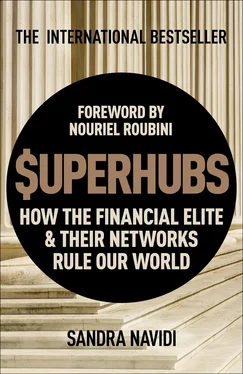Sandra Navidi - SuperHubs - How the Financial Elite and Their Networks Rule our World
Здесь есть возможность читать онлайн «Sandra Navidi - SuperHubs - How the Financial Elite and Their Networks Rule our World» весь текст электронной книги совершенно бесплатно (целиком полную версию без сокращений). В некоторых случаях можно слушать аудио, скачать через торрент в формате fb2 и присутствует краткое содержание. Год выпуска: 2017, Издательство: Hodder & Stoughton, Жанр: Старинная литература, на английском языке. Описание произведения, (предисловие) а так же отзывы посетителей доступны на портале библиотеки ЛибКат.
- Название:SuperHubs: How the Financial Elite and Their Networks Rule our World
- Автор:
- Издательство:Hodder & Stoughton
- Жанр:
- Год:2017
- ISBN:нет данных
- Рейтинг книги:4 / 5. Голосов: 1
-
Избранное:Добавить в избранное
- Отзывы:
-
Ваша оценка:
- 80
- 1
- 2
- 3
- 4
- 5
SuperHubs: How the Financial Elite and Their Networks Rule our World: краткое содержание, описание и аннотация
Предлагаем к чтению аннотацию, описание, краткое содержание или предисловие (зависит от того, что написал сам автор книги «SuperHubs: How the Financial Elite and Their Networks Rule our World»). Если вы не нашли необходимую информацию о книге — напишите в комментариях, мы постараемся отыскать её.
SuperHubs: How the Financial Elite and Their Networks Rule our World — читать онлайн бесплатно полную книгу (весь текст) целиком
Ниже представлен текст книги, разбитый по страницам. Система сохранения места последней прочитанной страницы, позволяет с удобством читать онлайн бесплатно книгу «SuperHubs: How the Financial Elite and Their Networks Rule our World», без необходимости каждый раз заново искать на чём Вы остановились. Поставьте закладку, и сможете в любой момент перейти на страницу, на которой закончили чтение.
Интервал:
Закладка:
In 2015, the Financial Times described female money managers as a critically endangered species. Although “funds majority-owned by women had outpaced the hedge fund industry as a whole in the preceding six-and-a-half years” and “female hedge fund managers outperformed men over 2013 as a whole,”8 the number of female portfolio managers had steadily declined.9 So despite research showing that greater diversity leads to lower risk-taking, more long-term thinking, less biased decision making, and greater return on capital, there are even fewer women in senior executive positions across the financial sector now than before the crisis. Even if they make it to senior levels, women typically get stuck in their late forties and early fifties because even in senior positions they are rarely plugged into the power and information channels to the same extent that men are. If they do make it to the board, they often are “token” women and isolated when compared to men.10
Even in the innovative venture capitalist industry, women are marginalized. It is less formal than other more established fields of finance, but the lack of tradition and rules does not make it any easier for women. Many have described the environment as hostile and unwelcoming, and it is difficult for them to fight against a male establishment that is successful precisely because it thrives on risk and disruption, does not follow rules, and is constantly on the lookout for the next boundary to push. Not only is it hard for women to break into the clubby environment, but those who have succeeded are “leaving the industry in droves.”11 As of 2014, only 13 percent of venture-backed companies had at least one female cofounder, and only 4 percent of leading venture capitalists are women, although a study found that female-run startups produce a 31 percent higher return on investment than startups run by men.12 In general, white men hire white men.
This “progressive” sector is just as conservative and sexist as the rest of the financial industry, as numerous lawsuits have unearthed; especially when fund-raising, women often face misogynistic and inappropriate behavior. Tech billionaires, the history-making “industrialists” of our time, are exclusively male. In the venture capital industry, deep relationships are of utmost importance to source deals and form productive working relationships with entrepreneurs, who mostly happen to be male.
The main reason why so few women make it to the very top of finance is because they are largely excluded from the old boys’ network. The super-hubs in control prefer surrounding themselves with those whom they most identify with and feel comfortable around: other men. They develop tight inner circles of trust; which increases efficiency in big and impersonal institutions, as homogeneity and conformity increase comfort levels, facilitate communication, and reduce uncertainty. During the crisis, Sheila Bair, the chairwoman of the Federal Deposit Insurance Corporation (FDIC), experienced blatant exclusion from the boys’ network. Consequently, she wondered whether it was “gross incompetence or unbelievable disrespect . . . or just the all-boys network wanting to make the decisions among themselves, as many commentators have speculated. Maybe the boys did not want Sheila Bair playing in their sandbox.”13
The higher the rank, the more homogeneous the groupings become—and an all-male senior management team has few incentives to advocate women’s cases. Exclusion from such networks—and the valuable informal connections formed within them—is a distinct disadvantage, and men’s entrenchment in these structures gives them more social capital and bargaining power. Attempts to start women-centric networks so far have been of limited effectiveness, because too few women are part of the top-rank establishment, and lateral networking is necessarily limited in scope.14 One woman expanding such a network is Sallie Krawcheck, who has been one of the most successful women on Wall Street as CEO of Sanford C. Bernstein, CFO of Citigroup, CEO of Citi Wealth Management, and lastly as head of global wealth and investment management at Bank of America. The financial crisis cost Krawcheck her last two jobs, and after being let go from Bank of America she purchased the women’s network 85 Broads, which had been founded by a female Goldman Sachs partner as a platform for female senior executives. In 2014, Krawcheck gave it the clever moniker Ellevate and launched the Pax Ellevate Global Women’s Index Fund, which invests in companies highly rated in terms of advancing female leadership. The verdict on the Ellevate network’s effectiveness is still out, but it is a promising start.
THE NETWORKING GAP: SCHMOOZE OR LOSE
The comparative weakness of female networks also results from women’s dispositions. Studies show that women are more reluctant than men to use their peer-to-peer networks because they feel uncomfortable using connections opportunistically. Also, some argue that since women have had top job opportunities only for a few decades, they lack role models and are still learning practices that men have long internalized.15 Often women are hired for their soft skills to attract new clients, sell financial services, and maintain client relationships. Despite excelling in these roles, they have largely been unable to break into the male-dominated high ranks of finance.
Although assumed to be better at fostering relationships, women have yet to change long-standing patterns of network behavior that have existed for centuries. Frequently, they are promoted to project diversity, lending predominately male boards a superficial “alibi,” especially if their institutions cater to a diverse clientele. Moreover, it has been argued that women are hired to create “buffer zones” between management and the labor force or public, especially for positions in human resources or public relations.16, 17 This inertia is at least partly due to the fact that women are still constrained by ancient social values and norms originally based on physical strength, which was essential for many preindustrial professions. In today’s world, many of these norms are outdated, but organizations reflexively perpetuate traditional practices that seek to preserve their structures. As a survival technique, many women simply try to fit in and be “one of the boys.”
THE ASSESSMENT GAP: PERFORMANCE VERSUS POTENTIAL
It appears that even mediocre men have an easier time rising up the ranks. Perhaps that is because, as a 2012 McKinsey study reveals, women are judged on performance while men are judged on potential.18 The Harvard Business Review aptly notes that “we live in an era of self-celebration . . . where fame is equated with success, and being self-referential has become the norm. . . . [Bluster] and the alpha instinct are often mistaken for ability and effectiveness.”19 Women are typically more modest, and even when their performance is better, they lose out because masculine behavioral norms do not apply to them. Ambition in the current social context is not considered an asset for females, as it implies aggression, which is reserved for men.20 Accordingly, when women act more competitively, they are negatively perceived as lacking warmth. The culture of money—where money yields ever more money coupled with power—skews social dynamics even more and often rewards ruthlessness. As a consequence, powerful women tend to work harder in an effort to stress their merits over the presumption that they get ahead by capitalizing on their feminine charms.
In addition, studies show that men engage in visible workplace behaviors, while women are more private and sacrifice themselves in doing the majority of “office housework”—time-consuming administrative tasks that don’t get any credit.21 Moreover, there is a tendency to expect help from a woman, whereas a man’s help is rewarded. I have experienced this marginalization firsthand and attended meetings in which women were interrupted or ignored; when a man said the exact same thing ten minutes later, he was applauded. Women’s fear that talking too much reflects badly on them is well founded. While powerful men who talk at disproportionate length are judged positively, women who do so are perceived as less competent by both men and other women.22
Читать дальшеИнтервал:
Закладка:
Похожие книги на «SuperHubs: How the Financial Elite and Their Networks Rule our World»
Представляем Вашему вниманию похожие книги на «SuperHubs: How the Financial Elite and Their Networks Rule our World» списком для выбора. Мы отобрали схожую по названию и смыслу литературу в надежде предоставить читателям больше вариантов отыскать новые, интересные, ещё непрочитанные произведения.
Обсуждение, отзывы о книге «SuperHubs: How the Financial Elite and Their Networks Rule our World» и просто собственные мнения читателей. Оставьте ваши комментарии, напишите, что Вы думаете о произведении, его смысле или главных героях. Укажите что конкретно понравилось, а что нет, и почему Вы так считаете.












